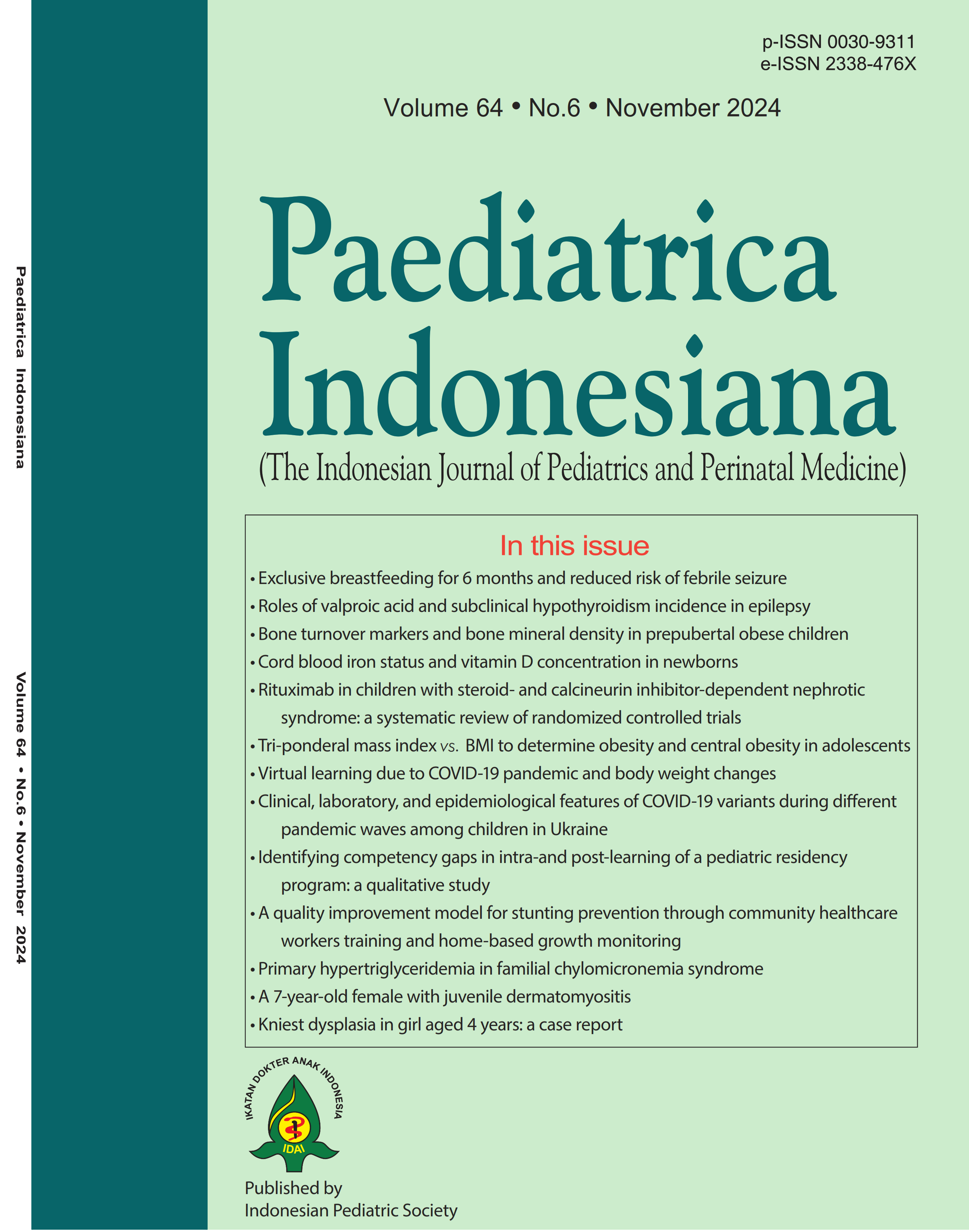Treatment duration and dosage of valproic acid and subclinical hypothyroidism incidence in pediatric epilepsy patients
Abstract
Background Epilepsy is a central nervous system disorder characterized by abnormal electrical activity in the brain.1 Prolonged administration of valproic acid at therapeutic doses can disrupt thyroid function, leading to subclinical hypothyroidism. This condition is marked by elevated thyroid stimulating hormone (TSH) levels, with normal serum free T4 (FT4) levels.2
Objective To investigate for possible associations between valproic acid therapy duration and dosage with the incidence of subclinical hypothyroidism in pediatric epilepsy patients.
Methods This analytical, cross-sectional study included children aged 4 months to 18 years treated at the Pediatric Clinic of RSUD Dr. Zainoel Abidin, Banda Aceh, from September to November 2023. Subjects diagnosed with epilepsy and treated with valproic acid for at least 3 months were included in this study and underwent FT4 and TSH examinations.
Results Forty-four children met the study criteria. Subclinical hypothyroidism occurred in 5 (11.4%) subjects during valproic acid therapy. Chi-square analysis revealed no significant association between therapy duration ?1 year (OR 1.286; 95%CI 0.193 to 8.568; P=1.00) or therapy dose ?20-40 mg/kg/day (OR 3.429; 95%CI 0.351 to 33.518; P=0.37) with subclinical hypothyroidism incidence.
Conclusion Neither the duration nor the dosage of valproic acid therapy were significantly associated with the incidence of subclinical hypothyroidism in children with epilepsy.
References
Miall L, Rudolf M, Smith D. Paediatrics at a Glance. Chapter 44. 4th ed. Ames: John Wiley & Sons Ltd; 2016. p.114-5.
Metwalley KA, Farghaly HS. Subclinical hypothyroidism in children: updates for pediatricians. Ann Pediatr Endocrinol Metab. 2021;26:80-5. DOI: https://doi.org/10.6065/apem.2040242.121
Passat J, Solek P. Epilepsi pada anak: gambaran umum. In: Soetomenggolo T, Ismail S, Handryastuti S, eds. Buku Ajar Neurologi Anak. Edisi Pertama. Jakarta: Badan Penerbit IDAI; 2022. p.:279-82.
Panaiyotopoulus CP. Epileptic seizures and their classification. In: Panayiotopoulos CP, editor: A clinical guide to epileptic syndrome and their treatment. London: Springer-Verlag; 2007. p. 21-63.
Elshorbagy H, Barseem N, Suliman H, Talaat E, Aishokary AH, Abdelghani WE, et al. The impact of antiepileptic drugs on thyroid function in children with epilepsy: new versus old. Iran J Child Neurol. 2020;14:31-41. PMID: 32021626
Mikati MA, Tarabay H, Khalil A, Raci AC, El Banna D, Najjar S. Risk factors for development of subclinical hypothyroidism during valproic acid therapy. J Pediatr. 2007;151:178-81. DOI: https://doi.org/10.1016/j.jpeds.2007.02.046
Aygun F, Ekici B, Aydinli N, Aydin BK, Bas F, Tatli B. Thyroid hormones in children on antiepileptic therapy. Int J Neurosci. 2012;122:69–73. DOI: https://doi.org/10.3109/00207454.2011.627486
Owolabi LF, Reda AR, Ahmed RE, Enwere O, Adamu P, AlGhamdi M. Electroencephalography findings in childhood epilepsy in a Saudi population: Yield, pattern and determinants of abnormality. J Taibah Univ Med Sci. 2020;16:86-92. DOI: https://doi.org/10.1016/j.jtumed.2020.10.016
Kim SH, Chung HR, Kim H, Lim BC, Chae JH, Kim KJ, dkk. Subclinical Hypothyroidism during Valproic Acid Therapy in Children and Adolescents with Epilepsy. Neuropediatrics. 2012;43:135–9. DOI: https://doi.org/10.1055/s-0032-1313913
McHugh JC, Delanty N. Epidemiology and classification of epilepsy: gender comparisons. Int Rev Neurobiol. 2008;83:11-26. DOI : https://doi.org/10.1016/S0074-7742(08)00002-0
Sinaga N, Widodo DP, Handryastuti S. Respon awal obat antiepilepsi monoterapi pada pasien epilepsi baru. Sari Pediatri. 2021;22:270-6. DOI: https://doi.org/ doi.org/10.14238/sp22.5.2021.270-6
Sibarani JJ, Deliana M, Saing JH. Valproat use and thyroid dysfunction in children with idiopathic epilepsy. Paediatr Indones. 2018;58:192-7. DOI: https://doi.org/10.14238/pi58.4.2018.192-7
Mikati MA, Khalil MN, Steele SU. Principles of drug treatment in children. Handb Clin Neurol. 2012;108:699-711. DOI : https://doi.org/10.1016/B978-0-444-52899-5.00023-X
Turan MI, Cayir A, Esin IS, Cayir Y, Tan H. Frequency of subclinical hypothyroidism at the patients that are using valproic acid. Med Science. 2014;3:1155-61. DOI: https://doi.org/10.5455/medscience.2013.02.8113
Sahu JK, Gulati S, Kabra M, Arya R, Sharma R, Gupta N, et al. Evaluation of subclinical hypothyroidism in ambulatory children with controlled epilepsy on valproate monotherapy. J Child Neurol. 2012;27:594–7. DOI: https://doi.org/10.1177/0883073811421985
Eiris-Punal J, Rio-Garma MD, Río-Garma MC, Loco-Rocamonde S, Novo-Rodriguez I, Castro-Gago M. Long-term treatment of children with epilepsy with valproate or carbamazepine may cause subclinical hypothyroidism. Epilepsia. 1999;40:1761-6. DOI: https://doi.org/10.1111/j.1528-1157.1999.tb01595.x
Copyright (c) 2024 Infra Yunita Carolina, Anidar Anidar, Rusdi Andid, Sulaiman Yusuf, Dora Darussalam, Nora Sovira

This work is licensed under a Creative Commons Attribution-NonCommercial-ShareAlike 4.0 International License.
Authors who publish with this journal agree to the following terms:
Authors retain copyright and grant the journal right of first publication with the work simultaneously licensed under a Creative Commons Attribution License that allows others to share the work with an acknowledgement of the work's authorship and initial publication in this journal.
Authors are able to enter into separate, additional contractual arrangements for the non-exclusive distribution of the journal's published version of the work (e.g., post it to an institutional repository or publish it in a book), with an acknowledgement of its initial publication in this journal.
Accepted 2024-11-04
Published 2024-11-04













